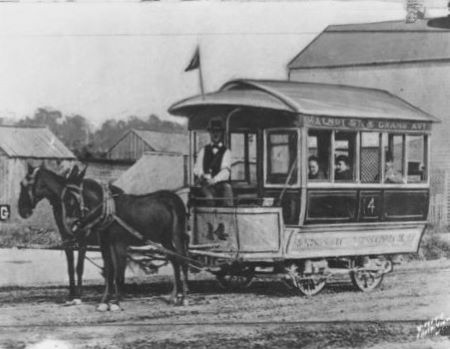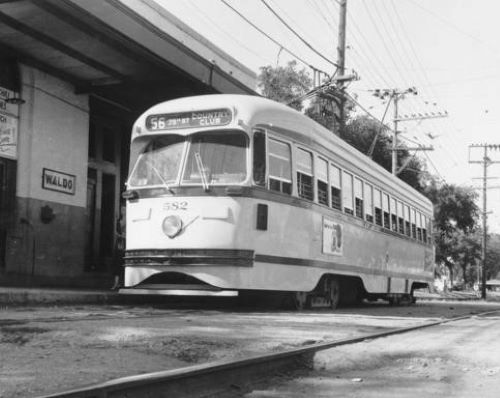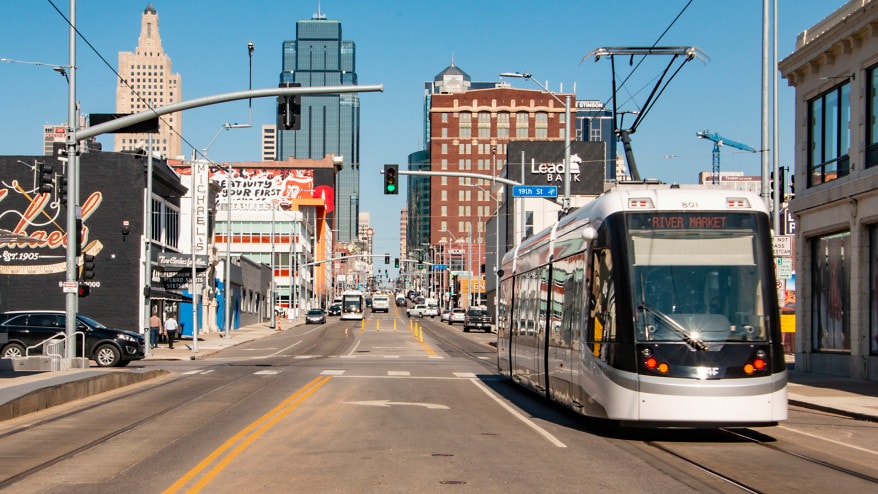Hitching a Ride Through History: The Evolution of Kansas City Public Transportation Streetcars, Trolleys and Buses by the Numbers
Published June 22nd, 2022 at 6:00 AM
Above image credit: A Kansas City streetcar in the 1950s. (Missouri Valley Special Collections | Kansas City Public Library)It may be hard to imagine today. But Kansas City was once home to the third largest cable car system in the United States — behind only San Francisco and Chicago.
Once known for its expansive transit system — before becoming extraordinarily dependent on the automobile — Kansas City has a deep and ever-evolving history of public transportation and ridership.
The history of public transit can be simplified into several overlapping eras, according to local historian and retired Metropolitan Community College professor Bill Worley. The first four eras include the mule and horse car era, the cable car era, the streetcar era and the introduction of buses.
The story, however, ends with a back-to-the future twist in the fifth era — the reintroduction of streetcars on Main Street in 2016.
The Beginning Streetcars
The first streetcars in Kansas City were pulled by mules and horses starting in 1869. Locally, mules were more common, Worley said. The cable car era began in the early 1880s in San Francisco. Very soon after, Kansas City began using cable cars in the same decade.

From 1895 to 1912, ridership increased from 31 million fare-paying riders to nearly 120 million riders, according to data compiled in the book “A Splendid Ride: The Streetcars of Kansas City, 1870-1957” by Monroe Dodd.
Kansas City became home to one of the most extensive cable car systems in the country, not seeing the last of the cable cars until 1912. After that, streetcars were electrified.
Ridership numbers broken down by type of transportation began in 1922, with 1922 to 1928 data documented in the 1928 Report on the Street Railway Situation published by the Kansas City Public Service Co.
In 1922, only railway revenue passengers were counted, with reports documenting over 136 million revenue passengers — the peak of the railway. The number of railway revenue passengers would never be as large again.
Even overall ridership of public transit would not get that high again until 1942 — during World War II —when it reached nearly 153 million revenue passengers.
Motor Buses and Automobiles
The arrival of the motor bus in 1924 introduced a new form of public transportation to Kansas City. In 1925, the first year motor bus data was documented, bus ridership made up only 1% of total revenue transit passengers.
In 1926, the Kansas City Public Service Co. took over running the city’s public transportation, consolidating ownership of public transportation. The company began replacing streetcars with buses where it would save money, but the change didn’t happen overnight.
From 1926 to 1937, data from Kansas City Public Service Co. reports showed a gradual migration from streetcar users to motor bus users. By 1937, the number of motor bus revenue passengers made up 20% of all ridership.
The introduction of motor buses was accompanied by automobiles, too, and Kansas City was no stranger to the Model T.
Many think of the Model T and think of Detroit, or the nearby suburb of Dearborn where the primary factory was built, Worley said.
“And that’s true, but they also produced it in 1908 in Kansas City,” Worley said. “Kansas City was the other Ford manufacturing plant — the only other Ford manufacturing in the entire United States at that time.”
Unlike the motor bus, automobiles were privately owned and not controlled by bigger companies, like the Kansas City Public Service Co., so only wealthy people could afford cars in the beginning.
The automobile takeover was a slow process, Worley said, since not many people could afford them early on. Initially, they didn’t pose an immediate threat to public transit.
Still, it was estimated that the 80% of people using mass transit to enter downtown dwindled to 50% by 1939, according to “A Splendid Ride.”
Trolleys and the Battle for the Streetcar
In 1937, the trolley bus was introduced, which was a hybrid between the streetcar and motor bus. The first year data was available for trolley ridership was in 1940 with reports of 9,724,027 trolley bus revenue passengers carried, making up 15% of the total riders for the year.
Reports for 1938 and 1939 were not available, but it still only took three years for trolley bus ridership to reach 15%. In comparison, the motor bus did not reach at least 15% until its 11th year of service.
Overall ridership of public transportation was beginning to make a comeback following dips in ridership during the Great Depression.
Streetcar ridership rebounded slightly in the 1940s with World War II. Gasoline was rationed, so the electrified streetcars were unaffected. Meanwhile, both cars and buses required gasoline to run.
The comeback still wasn’t enough to save the streetcars. A variety of factors including the growing prevalence of automobiles, construction of new highways and the migration of people to the suburbs ultimately brought an end of the streetcar.
In August 1955, the board members of the Kansas City Public Service Co. unanimously voted to sell all 144 street cars, according to an article from the Kansas City Times from Aug. 13, 1955.
The company was negotiating sales for streetcars to be used in a “European city with a rail system of the same gauge as in Kansas City.” All of the trolley wires and other equipment would also be sold.

At the time of the article, there were only six streetcar lines still in existence: Country Club, 31st Street, Troost Avenue, 12th Street, Dodson and the Rockhill.
While the decision would save money overall, not everyone agreed with the switch. Another article from the Kansas City Times reported on the City Council meeting when the streetcar decision was introduced. With about 40 people attending, seven spoke against the decision.
One resident who spoke against the decision was Joe Gregg, a University of Kansas City student who brought a petition with 150 signatures — all against banning streetcars.
The reasons cited streetcars being more comfortable, quieter and safer. Another resident in opposition, Robert B. Langworthy said of the people who “spoke for the proposal, none spoke as a transit rider.”
A petition against the removal of the final streetcars was even up to over 11,000 signatures by April 1957, according to coverage from the Kansas City Times. In the same year, the population was 854,000.
‘Farewell to the Street Cars’
In 1957, the last streetcars in Kansas City were removed. Buses became the primary public transit option in the Kansas City area.
“A quarter of a century ago, Kansas City had 800 street cars. For the rest of this week it will have 41. Next Sunday, all will be gone,” read an article from the Kansas City Star in June 1957. “This is the week to say good-by to Kansas City’s street cars.”
In 1965 the Kansas City Area Transportation Authority took over transit operations and is still in charge today. From there, automobiles take over, Worley said.
In 1970, total ridership had decreased by over 64% from 1955. From there, data continued to trend down into the turn of the century.
The Streetcar Returns
The Kansas City public transportation system, in many ways, looks both different and similar to the way it did when ridership was at its highest.
The new streetcar debuted in May 2016 with nearly 1.4 million unlinked passenger trips for the partial year. Trips peaked in 2019, reaching over 2.2 million unlinked passenger trips.
Without paid fares, ridership is measured using automatic passenger counters placed above streetcar and bus doors — counting passengers each time they enter a vehicle regardless of how many vehicles they take. These measure unlinked passenger trips, which are also used by the Federal Transit Administration as the national standard for measuring transportation use.
Free fares are a new part of public transportation, with the new streetcar — running from Union Station to River Market — being permanently free.
The COVID-19 pandemic reduced streetcar ridership, but it never stopped running.
Now, streetcar ridership is running at about 75% of pre-pandemic rates, according to Donna Mandelbaum, communications and marketing director for the Kansas City Streetcar Authority.
As of May 2022, ridership for the year totaled 529,752 unlinked passenger trips.

Buses also continued to run during the pandemic, even beginning a free-fare program in 2020 that had been planned to gradually take place beginning years prior. The program, according to Dick Jarrold, senior vice president of RideKC, helped keep both operators and passengers safe by limiting contact.
Cindy Baker, interim vice president of marketing and communications for the Kansas City Area Transportation Authority, said they plan to continue the free fare service through at least 2023.
“You know, we hope to go beyond that, but we do have to look at a variety of revenue sources and partnerships to continue the program,” Baker said.
Bus driver shortages have led to the sort of staffing issues many businesses have seen. Baker said pre-pandemic, there used to be an “extra board,” or 12 to 15 backup bus drivers. Now, the authority has none.
“We are always taking applicants and really looking for folks to apply, go through training and get on there actually helping us deliver the service,” Jarrold said. “Recruiting has been ramped up significantly.”
As for overall transit ridership, trends have continued to decrease over the past few decades, even before the pandemic. The most recent decrease began in 2013 and 2014. Ridership went from 16,166,950 passenger trips in 2012 to 12,044,179 in 2019, getting as low as 9,139,474 in 2021 during the COVID-19 pandemic.
Kansas City has become less dense as a community, which is one cause of the decrease in ridership, according to Jarrold. Many communities in the country follow the trend, too.
“We are, as many communities are, autocentric, and invest significantly in roads, highways, etc.,” Jarrold said. “So that, over the long haul, has had an impact on transit and transit ridership.”
For now, Kansas City’s public transportation and ridership continue to evolve — even through a pandemic.
“The streetcar, I think, has changed a lot of people’s ideas about transit and what that means for the future,” Jarrold said.
Annie Jennemann is a Dow Jones data journalism reporting intern. She is a graduate student at the University of Missouri.


